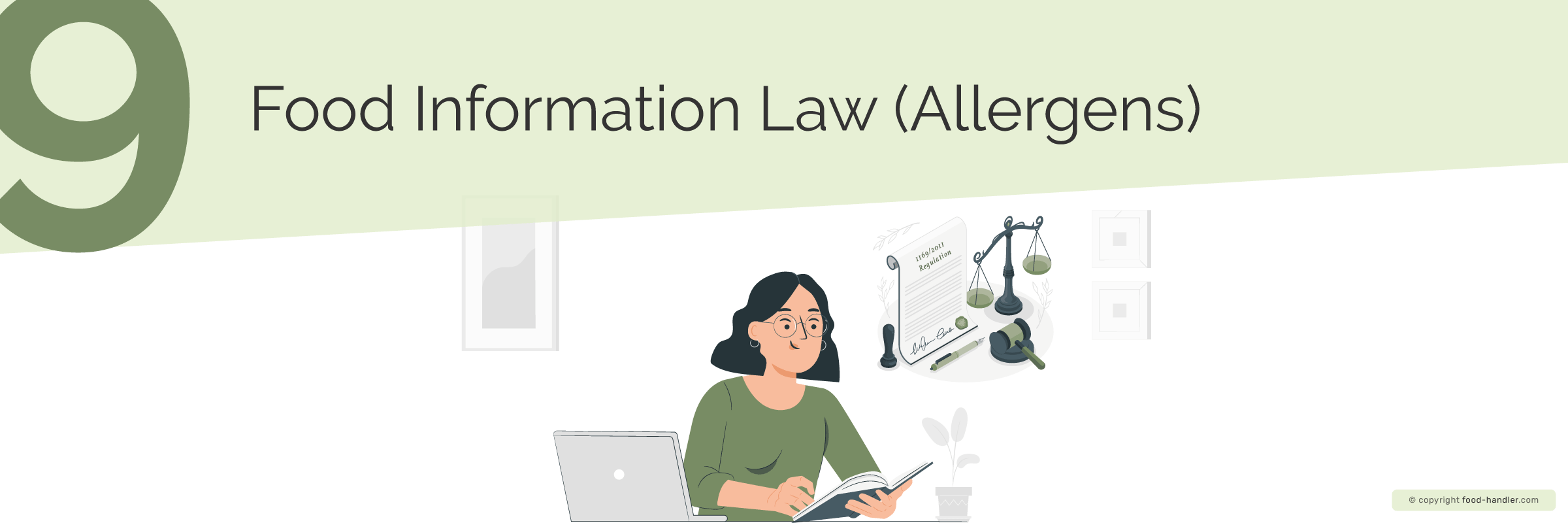FOOD HYGIENE AND SAFETY - LEVEL 2 COMPLIANT - CERTIFICATION


Updated on 2026
Lesson 9: summary

According to the 1169/2011 regulation, known as the Food Information Law (Allergens), since December, 2014, every food operator is obliged to report on the allergens present in its products through a system that allows them to be clearly identified.
Who must comply with the Food Information (Allergens) Law?
Restaurants, bars, cafeterias, hotels, supermarkets, food stores, canteens and, in general, any establishment offering packaged or unpackaged products.
* Food processors must indicate this directly on the labelling of the product itself.
How to inform about the presence of allergens?
The rules are unclear in this regard and leave this to the food operator, who is required to make this information clear, effective and accessible to the customer. Possible options include information leaflets, posters, icons on the menu, etc.
What are the allergens I should inform about?
Although there are many possible allergens, only those containing any of the following 14 elements* are required to be reported:
* This list can be modified or extended by the European Union according to its own criteria, so it is necessary to be informed and updated about possible changes in this list.
Although it is not mandatory, it is recommended to inform about the possibility of traces or possible cross-contamination of allergens in our products.
Lesson 9: extended
The purpose of the 1169/2011 Regulation is to respond to the need for specific legislation on food labelling and to oblige local authorities to provide consumers with all the information on the 14 allergens that can be found in the dishes and foods they offer.
The regulations governing food allergens provide that information can be given in various forms, but what is required is to ensure high protection, i.e. the specific name of the allergen contained in the food (e.g. shrimp instead of crustacean or cuttlefish instead of mollusc).
Thus, the information can be found on labels affixed to pre-packaged food, labeled on posters or by other appropriate means (a menu or letter, or orally, or through a recipe book of the products sold in the establishment.
In any case, the information must be easily accessible to the consumer and may in no case entail additional costs. In buffets and self-service restaurants, information should be posted next to or near the food on signs clearly visible to the consumer.
It is important to know that, although the information is provided orally, there must also be a record, either physically or electronically.
Violations committed by companies that do not comply with food safety regulations are sanctioned with fines ranging from 5,000 to 600,000 €, and in the case of very serious violations, the competent public authorities may agree to close the establishment for a maximum of 5 years.
The European standard establishes the correct labelling regulation, indicating that it must be clear and legible. To this end, a minimum font size for the mandatory information of 1.2 mm is set. However, if the maximum surface area of a container is less than 80 cm², the minimum size is reduced to 0.9 mm.
If it is less than 25 cm², nutritional information is not mandatory. For packages with a larger surface area of less than 10 cm², there is no need for nutrition labelling or ingredient listing.
However, the name of the food, the presence of possible allergens, the net quantity and the date of minimum durability must always be indicated, regardless of the size of the package.
Similarly, it is also necessary to indicate allergens present in unpackaged foods sold to the final consumer.
Unprocessed products that include a single ingredient or a single category of ingredients are not required to incorporate nutrition information on the label.
One of the new features of European Regulation 1169/2011 is the obligation to indicate the country of origin on the label. Before this law it was only mandatory to indicate the country of origin of foodstuffs such as fresh beef, fruit and vegetables, honey, or olive oil. This law also requires fresh pork, sheep, goat and poultry meat to be labelled with the label of the country of origin of the food.
Implementing (EU) 2018/775 regulation became mandatory as of April 1st, 2020. The new provisions aim to redress the error induced in consumers by the labeling of the country of origin of foods when the primary ingredient (more than 50% of the food) is obtained elsewhere. If the country of origin differs from the origin of the primary ingredient, "the country of origin of the primary ingredient or an indication that it has a different country of origin from that of the food" must be specified.
We use 256 bit SSL encryption technology to guarantee the security of our website. You are safe with us.